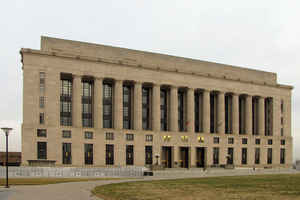Davidson County, Tennessee
Davidson County Education, Geography, and History

Davidson County is a county located in the state of Tennessee. Based on the 2010 census, the population was 626,681, making it the second-most populous county in Tennessee. Its county seat is Nashville, the state capital. Davidson County is the oldest county in the 41-county region of Middle Tennessee. It dates to 1783, when the North Carolina legislature created the county and named it in honor of William Lee Davidson, a North Carolina general who was killed opposing General Cornwallis and the British Army's crossing of the Catawba River on February 1, 1781.
In 1963, the City of Nashville and the Davidson County government merged, so the county government is now known as the "Metropolitan Government
of Nashville and Davidson County," or "Metro Nashville" for short.
Davidson County has the largest population in the 13-county Nashville-Davidson–Murfreesboro–Franklin Metropolitan Statistical Area. Nashville has
always been the region's center of commerce, industry, transportation, and culture, but it did not become the capital of Tennessee until 1827 and
did not gain permanent capital status until 1843.
Etymology - Origin of Davidson County Name
Named in honor of William Lee Davidson (ca. 1746-1781), colonial soldier, Revolutionary War officer in the North Carolina Third, Fourth and Fifth Regiments who was killed in action at Valley Forge.
Demographics:
County QuickFacts: CensusBureau Quick Facts
History of Carter County
The first white settlers established the Cumberland Compact in order to establish a basic rule of law and to protect their land titles. Through
much of the early 1780s, the settlers also faced a hostile response from Native American tribes who resented their encroaching on their territory
and competing for resources. As the county's many known archaeological sites attest, Native American cultures had occupied areas of Davidson County
for thousands of years. The first whites to enter the area were fur traders. Long hunters came next, having learned about the large salt lick, known
as French Lick, where they hunted game and traded with Native Americans.
In 1765, Timothy Demonbreun, a hunter, trapper, and former Governor of Illinois under the French. and his wife lived in a small cave (now known as
Demonbreun's Cave) on the south side of the Cumberland River near present-day downtown Nashville. The first white child to be born in Middle
Tennessee was born there.
Created 1783 by Act of North Carolina; named in honor of William Lee Davidson (ca. 1746-1781), colonial soldier, Revolutionary War officer in the North Carolina Third, Fourth and Fifth Regiments who was killed in action at Valley Forge.
Davidson County was formed in 1783 by an act of the state of North Carolina. (Laws of North Carolina, Acts of 1783, Chapter 52).
During the June 8, 1861, referendum, the closely divided population of Davidson County voted narrowly in favor of secession: 5,635 in favor, 5,572 against. Middle Tennessee was occupied by Union troops from 1862, which caused widespread social disruption in the state.
Tennessee Encyclopedia of History and Culture
Davidson County is the oldest county in Middle Tennessee. It dates to 1783,
when the North Carolina legislature created the county and named it in honor of
William L. Davidson, a North Carolina officer who died in the Revolutionary War
on January 1, 1782. The county seat, Nashville, is also the oldest permanent
white settlement in Middle Tennessee, founded by James Robertson and John
Donelson during the winter of 1779-80. The initial white settlers established
the Cumberland Compact in order to establish a basic rule of law and to protect
their land titles. Through much of the early 1780s the settlers also faced a
hostile response from Native American tribes. As the county's many known
archaeological sites attest, the resources of Davidson County had attracted
Native Americans for centuries. In fact, the first whites to encounter the area
were fur traders, then long hunters, who came to a large salt lick, known as
French Lick, in present-day Nashville to trade with Native Americans and to hunt
the abundant game.
Nashville has always been the region's center of commerce, industry,
transportation, and culture, but it did not become the capital of Tennessee
until 1827 and did not gain permanent capital status until 1843. Its story is
best told through its individual entry and the hundreds of other entries in this
volume that cover significant people, events, and institutions associated with
Nashville as the capital city of Tennessee. Find more from the Tennessee Encyclopedia of History and Culture:
DAVIDSON COUNTY
Geography: Land and Water
As reported by the Census Bureau, the county has a total area of 526
square miles (1,363 km2), of which, 502 square miles (1,301 km2) of it is
land and 24 square miles (62 km2) of it (4.53%) is water.
The Cumberland River flows from east to west through the middle of the
county. Two dams within the county are Old Hickory Lock and Dam and J. Percy
Priest Dam, operated by the United States Army Corps of Engineers. Important
tributaries of the Cumberland in Davidson County include Whites Creek,
Manskers Creek, Stones River, Mill Creek, and the Harpeth River
Neighboring Counties
Bordering counties are as follows:
- Robertson County, Tennessee - north
- Sumner County, Tennessee - northeast
- Wilson County, Tennessee - east
- Rutherford County, Tennessee - southeast
- Williamson County, Tennessee - south
- Cheatham County, Tennessee - west
Education







